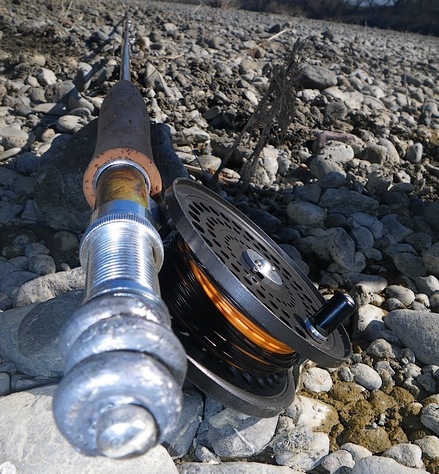I’ve always thought lightness was among the most misunderstood qualities of fishing tackle. Manufacturers tell us how much better it is to have it, but I’ve always chalked that up to the engineer’s zeal – as it has little or no bearing with fishing.
I’ve heaved 12’ surf rods and a six ounce pyramid at striped bass for most of a day, and I’ve flung a 7.5’ #3 until darkness made me quit, and by day’s end both rods weighed heavy.
The lightest bamboo rod is still heavier than a graphite, a bead head nymph is heavier than its regular counterpart, a fly line can be a half size heavier, and while there are thousands of opinions and zealots that swear by one over the other, none will tell you that lightness outweighs the merits of what they prefer most.
… and if he’s fishing all day, no matter whether it’s saltwater or fresh, regardless of the terminal tackle being a nine weight or a five, all rods are heavy come twilight – especially so if there’s an uphill climb to the parking lot, or you’ve been skunked.
“Lightness” is something that engineers grow turgid over, while us fishermen look the other way and sigh.

Knowing that the next ten days had forecast rain, I met up with a pal to see if we could find some fish. While I’m fiddling with my rod I glance down at [anonymous_meathead’s] weapon and spy three 3/8 ounce lead sinkers attached to the butt.
Images come unbidden, how that engineer rushes into his boss’s office out of breath, exclaiming, “Boss, I got this new resin made with superlight stuff, it appears as if it doesn’t screw up the existing stuff, so we can charge double for our stuff even though it’s half the weight of their stuff!”
… naturally the boss rushes to the elevator so he can tell his Boss in like frenzy …
Then how the marketing manager puts a handkerchief over his handset so he can call all his sales cronies at the other rod companies and claim, “your kung-fu is weaksauce, ‘cause ours is way lighter.”
Which later translates into a litany of superlatives used by hairdressers and chefs – to describe a good soufflé or chocolate mousse, but has little to do with fishing as the addition or subtraction of an ounce is something we do simply because we feel like it …

Milan scratches his head before every cast.
do you recall when medalist reels boasted of their ability to take weights to perfect their balance with your rod of choice?
A Medalist 1492 and Fenwick Feralite were standard issue in my family. I think everyone ever built still works, they were the Sherman tank of fly reels.
Some had better armor, many had better guns, but the Sherman carried the day via weight of numbers…
I still use my medalist to salmon fish in the fall.
When I was a kid, I couldn’t wait til I saved up enough money to upgrade to my first Medalist. They looked so cool. Still got ’em and, after 40 years, they still look cool.
“Lightness” is misunderstood in a few industries.
I used to build bicycles. I built them from steel tubing with lugs. They were functional, beautiful, repairable and light enough. Then, along came aluminum and “carpet fiber” and an industry began to change. I don’t think for the better.
Instead of repairing and maintaining, cyclists now upgrade and replace ever more expensive and fragile machines. Craft and artistry are more and more a niche that is retro or frumpy. The newest, most expensive, “lightness” must be consumed. No mater how powerful the motor (rider) is; that new, exclusive object will improve their performance.
As with fly rods, fewer than 90% of users probably use a bicycle to it’s maximum potential, myself included. So, why not enjoy what one can do and do that best that one can, with a product that doesn’t cost the downpayment on a house?
All hail the Medalists, Feralites and steel bicycles of the world. The real people need them so they can go out and play.
John Peipon-well said!
I’ve got a favorite fifteen foot spey rod that is a bit hefty by contemporary standards. Interestingly, that bit of extra mass actually helps to drive the cast. Butter smooth and powerful, this thing defines the term “effortless casting.” It’s also reasonably affordable compared to some “high end” rods. It was designed solely as casting and fishing tool, not a status symbol or conversation piece.
Erik Helm once described a lot of the angling consumers out there as “attempting to buy a skill advantage.”
John Geirach tells the apocryphal story of the old feller who says ” spend half what you paid for that rod on some casting lessons, and you’ll get your extra distance.”